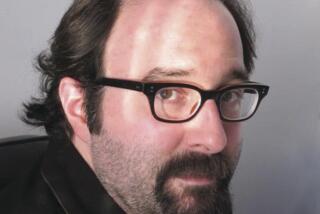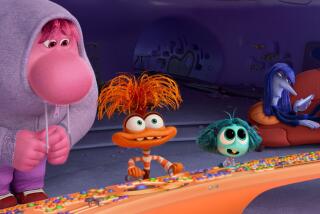Family Fare
- Share via
Aficionados might reasonably differ over which were the vintage years for atomic films. As “Celluloid Mushroom Clouds” shows, the years from 1953 to 1955, a cusp moment in the on-screen development of nuclearized America, should be near the top of anyone’s list. In the Arctic, the first radioactivated monster, Ray Bradbury’s famed Rhedosaurus, awakened in “The Beast from 20,000 Fathoms” and began its long slouch toward New York City; in the Southwestern desert, near the Trinity testing grounds for the first atomic bomb, a giant mutated queen ant in “Them!” prepared for her flight to the sewers of Los Angeles to spawn; in space, the planet Metaluna displayed “the consequences of a weak defense system” by suffering incineration in “This Island Earth”--and let’s not ignore the return of the irrepressible. In 1954, Godzilla, awakened by atomic tests, stomped out of Japan’s Toho studios and (though worth only a footnote in this Hollywood-centric book) later barnstormed through American theaters.
Each of these successful films (“Them!” was Warner Bros.’ highest grosser of 1954) was aimed at family audiences. But for the highest low point of the on-screen atomic age, my vote goes to 1957, when the Hollywood studio system was atomizing as family audiences deserted movie theaters for the suburbs and television. Suddenly, the teenager looked like a demographic worth making movies for. According to Joyce A. Evans’ “quantitative database,” 1957 wins hands down for the largest number of “nuclear genre films,” even if it also scores poorly in “dialogue devoted to ethical implications and justification of atomic development.” But what exactly might those “ethical implications” have been in that glorious year when the Black Scorpion, the Incredible Shrinking and the Amazing Colossal Man, the Invisible Boy, the Cyclops, the Deadly Mantis, the Giant Claw and “an enlarged radiated stump” from the grave of a South Pacific islander--atomic mutants all--were sent careening toward teenagers in drive-ins across America?
Such films were generally made by Hollywood bottom-dwellers, indies like Roger Corman (“Attack of the Crab Monsters”) producing what the trade journals then called “weirdies.” The typical weirdie was shot in fewer than 10 days on a budget of less than $100,000, and producers “sometimes invested the majority of the budget into high-powered, sensational advertisements.” “Basically,” observes Evans, “all a producer needed was a high-concept title.” It helped as well to have a high-anxiety news event that might send a few Cold War-ish chills through the public, say, a major atomic test series or the launching of Sputnik. (Evans reports that 43 science-fiction film projects “were announced in the trade papers the day after” that satellite’s launch.)
If the cheapo monsters and monstrous aliens of atomic films were more frightening in ads than on the screen, it hardly mattered. Their youthful audiences had other things on their minds than the nuclear age. In fact, it could safely be said that neither the makers nor the viewers of most “nuclear genre films” paid one-tenth the attention to them that Evans does. Perhaps, though, every B film genre deserves its own B scholarly book.
In “Celluloid Mushroom Clouds,” Evans, who teaches at UC San Diego, takes a narrow view of how the fallout from Hiroshima and Nagasaki hit American culture. She analyzes Hollywood’s reactions to the nuclear age from 1945 to 1964, trying to show how an entertainment business, in search of profits and under economic and governmental pressures, subsumed and reshaped images for a new age.
Just after the war, as she tells the tale, Louis B. Mayer, head of MGM, was eager to document the development of the first atomic bomb and its use against Japan. After complex negotiations with Albert Einstein, top Manhattan Project nuclear scientists, the Pentagon and Truman administration officials, MGM released “The Beginning or the End?” in 1947 as “the bottom half of a double bill with a Red Skelton comedy.” A confused docudrama, high on nuclear anxiety and on justifications for nuclearizing Japanese cities, it failed dismally at the box office.
Hollywood, Evans indicates, learned its lesson with amazing speed. Americans did not want to see the final moments of their latest victory served up reasonably straight on the screen. They did not want discussions about the ethics of the atomic bombings (and neither did their government). Evans does not say it, but the obvious genre for the atomic film, the war movie, proved inhospitable because the penultimate scene on which it so often relied, in which the enemy fell in prodigious numbers before our triumphant forces, was in this case unviewable. The Enola Gay, the plane that carried the bomb to Hiroshima, flew away from “that awful cloud” (as its pilot called it) and out of movie history.
With the exception of a single failed Cold War propaganda film, “Above and Beyond” (1952), the atomic film of the 1950s held onto a semi-documentary look but fled reality for the farthest reaches of the globe or the galaxy. The Enola Gay and its weapon quickly transmogrified into spaceships, rays and monsters of every kind, intent mostly on attacking our largest cities. As “Celluloid Mushroom Clouds” so fully documents, atomic films became an entire genre under the wing of that riotous cinematic weed of the 1950s: science fiction. (“Mutated sea creatures were offered to film audiences every year from 1953 to 1957” is a typical Evans observation.) An actual plane carrying an atomic bomb would not fly back on-screen in a “war film” until the 1960s. In “Fail Safe” and “Dr. Strangelove,” Americans could again be imagined as responsible for the world’s imminent demise. In the years between, as Evans describes it, brave American military men, FBI agents and military scientists attempted to protect us on-screen from every imaginable mutant thought.
“Celluloid Mushroom Clouds” offers powerful evidence of how quickly the Hollywood branch office of the popular culture business tamed the bomb--and the act of bombing--creating a genre that scholars could analyze just as they might juvenile delinquency or beach blanket bingo teen films. Evans certainly has done her work exhaustively, not to say exhaustingly (though I wondered why “The Mouse That Roared,” with its “Q-bomb” and its unique comic plot about disarming the superpowers, was missing). She doggedly searches her films for various kinds of atomic evidence, even if she shows little evidence of what’s most remarkable about “nuclear genre movies”: how quickly the fallout from one of the two most horrifying events of our century, the one Americans were responsible for, was transmuted in resplendently unbombed America into entertainment for teenagers. (There are, after all, no 1950s “Holocaust genre films” to analyze.)
One must learn to appreciate the glories of a B book as one appreciates those of a B movie. Works like this one, in which a scholar must deal with a “cucumber-like creature” that teams up with an “intensely power-hungry scientist” to turn people into “subservient zombies” (“It Conquered the World,” 1956), are meant to be hijacked by others for uses weirder than their authors imagined possible. Evans, for instance, writes predictably about Cold War anxieties, but shouldn’t someone explore what strange pleasures were associated with the bomb? How about, as a start, the real anxiety-producing subject of every drive-in teen atomic adventure--making out?
And speaking of pleasure and the bomb, how about those folks at the Atomic Energy Commission? In the mid-1950s, fearful of rising public anxiety about fallout from atomic tests, the commission, Evans notes, began promoting “ ‘atom bomb watching’ as a tourist attraction for vacationers in Nevada.” There were even bleachers on a hill (“News Nob”) 10 miles from ground zero for reporters.
We’ve been on that hill ever since, thanks in part to Hollywood, and Hollywood, which tamed our A-bombings of Japanese cities and avoided almost every issue they might have raised, has nonetheless led us as tourists into some culturally irradiated zone.
In 1947, an awed reviewer for Variety commented that if the real-life counterparts of the characters in “The Beginning or the End?” had failed to create an American bomb, no one might have been viewing such a film. “In truth,” the reviewer wrote, “had the Germans won the race for the secret weapon we might have been Hiroshimated instead.” Though the Germans were never close, we can still regret that such an apt word as “Hiroshimated” never made the leap into our dictionaries. We could do worse as we once again consider the bombings of Hiroshima and Nagasaki than to wonder whether the United States wasn’t “Hiroshimated,” but it would take a Hiroshimagination to know what that meant for us all, on- or off-screen.
More to Read
Only good movies
Get the Indie Focus newsletter, Mark Olsen's weekly guide to the world of cinema.
You may occasionally receive promotional content from the Los Angeles Times.









